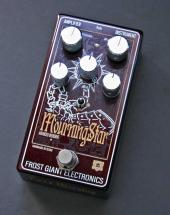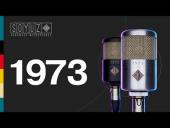Screwed Circuitz Programmable Tremolo
Brands:
This is an effect pedal and its purpose is to modulate the amplitude of any sound source generating a unique rhythmic pattern of your choosing.
It is digitally controlled but has a very analog feel and texture in the way that it handles your sound source.
In order to record a sequence on the Programmable Tremolo you will need:
-
One or two audio input sources of your choice, for example, a guitar, a microphone, a synthesizer, etc.
-
One or two output sources of your choice, as an example, an audio effect, an amplifier, a sound card,
mixer and anything else you can think of.
It is important to note the power supply is 9V DC with a minimum of 150mA any polarity.
Your sound source will be going through passive components only, therefore, it will not damage any equipment inputted or outputted. In fact you can actually expect a small drop of power at the output. Explore the rate knob from left to right, witness how the light goes from red and blue until blue and green.
When the LED is at its brightest red colour, the volume of your left channel is at its maximum. Rotating your knob towards the centre, the red will diminish and the blue light will be dominant. This indicates that your left channel is decreasing in volume until it is off. The blue LED signifies that your volume is at the lowest point or off. Rotating from the centre to right, the same principle applies for the green LED in relation to your right channel.
Your right and left channels are represented by plastic 1/4’’ jacks.
To create an interesting sequence, here are the step by step instructions:
-
The first step to start recording your sequence, is to make sure your “rec/rate” switch is placed downwards (at the off position) pointing to the rec setting.
This is essential or it will not record your steps.
-
Press “start” to initiate the recording process.
-
When you have found the desired position of your rate knob, press and hold the momentary push button “steps”. This will record the first step of its position and volume.
-
Once the momentary push button is released, time will stand still, giving you the opportunity to reposition your rate knob.
-
A good way to know that you are in fact in record mode is to pay attention to the LED movement. The colour of the light will lock into its last position no matter where you position the knob afterwards. Once you press steps again, your LED will lock into its new position.
-
Your next step will only be recorded once the “steps” button is pressed again.
-
You can repeat the previous steps as many times as you like, with a maximum of 150 entries.
-
The time held down will be the exact time played back. For example, if your first step is held down for four seconds, your playback for that step will be of four seconds.
-
When you are done recording your steps, press “start” one more time in order to start the sequence.
-
Your sequence will then start playing at the exact same speed as when you punched it in. Once you’ve reached the end of your sequence, it will go back to the start and loop endlessly.
-
To adjust the speed of your loop, flip the switch towards the rate label (or to the on position) and use the “rate” knob to control the speed of your sequence. It can range from your original sequence when turning towards the left to extremely fast when turning towards the right.
-
In order to return to the original speed of your loop, you can bring the switch downwards (to the off position) or towards the rec label.
-
Lastly, when you are ready to create a new sequence, press clear. You will see the blue light only, and momentarily after, the red or green light will turn on depending on the placement of your rate knob.
-
You are now ready to start a fresh sequence.
All three 1/4 jacks can be inputs or outputs and you will get different results depending on the way you assign them.
The four ways you can use this effect:
-
By sending an input through the metal 1/4’’jack and choosing one of the two plastic jacks as the output, you can create interesting patterns of tremolo.
-
Another way to set it up is going into the metal jack and using both left and right channels as outputs in order to create unique patterns of auto-panning.
-
You can also use the right and left channels as inputs and have the metal jack be your output. This allows you to slice and dice 2 different instruments.
-
If you chose any one of the left or right channels as the input and the other one as the output you can chop your sound coming in and again going out.
I hope these instructions helped you understand how to work and record your own sequence.
The effects of the Programmable Tremolo were built to inspire. Whenever you feel creative, reach for the programmable tremolo and have a totally unique sound experience!
No save function for now so make sure to record your performance!







